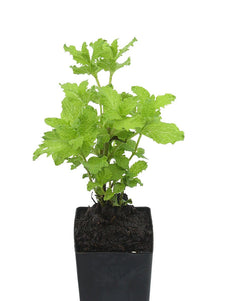



Mint - Egyptian Mint
Mint - Egyptian Mint

- Low stock - 2 items left
- Inventory on the way

Usually available: All year
Life cycle: Perennial
Height: 60 - 90cm
Position: Sun / part shade
Soil preference: Moist / well drained
This is how we pack and send your Herb Plants to all states except TAS & WA
You will receive
- 1 Egyptian Mint Herb Plant in a 50 X 75mm tube - General growing instructions
All of our Herb Plants are grown organically with certified organic potting mixes and fertilizers
Botanical Name: Mentha niliaca
Egyptian Mint is a rare mint with a distinctive growth habit that is more open than other mints. It reaches up to 90 cm tall and has a width of 30cm. The long, pointed, deep green leaves are covered in a fine down of hair giving them a silver –grey sheen. The leaves are textured, serrated and sometimes curving downwards from the sturdy upright stems. The purple flowers are held at the end of tall stalks, which branch off the stems.
This uncommon hybrid plant has a flavour similar to Apple Mint and is milder than Peppermint and Spearmint. Egyptian Mint is an ancient culinary plant known to be used since the time of the Pharaohs. It is also suggested that it may be one of the mint plants referred to in the bible and does grow wild in biblical regions. The botanical name is Mentha X niliaca, but Mentha sylvestris is a scientific synonym that may be seen.
Mint General
There are many Mint varieties known to herb gardeners and lovers of good cuisine, all varying slightly in flavour, aroma and appearance. They are categorized in the genus ‘Mentha’, which has up to 18 species, within the Lamiaceae family of plants. The Lamiaceae family is known as the mint family. However, the largest group of plants in the mint family is actually the delightful Salvias with their brilliantly coloured blooms. Many other commonly known herbs are also found in this family, including basil, sage, thyme and even lavender. One characteristic of this plant family is that they all yield essential oils, giving each plant its unique characteristics and even potential for medicinal use. Even the Scutellaria genus, with the unusually named Baikal Skullcap is found within this family.
The mints consist of mostly spreading and low growing perennial plants. The height range is from 10 cm to 1 meter, so not all are at ground level. Mint plants send out runners, or stolons, to help them spread by developing roots and shoots at the nodes. This allows plants to cover up to 1 meter in stem growth, in good conditions. They are all fast growing plants and due to the spreading nature, one plant is often sufficient for most gardeners. Some mints can be invasive and it is recommended that containers or in ground barriers be used. Mints can suffer from some pests like snails and aphids and may be affected by mint rust. Rust Free Mint may also be a useful addition to the garden in addition to the many other varieties.
Most mint plants have square stems, with leaves held in opposite pairs. They are often downy with a serrated margin, with a variable leaf shape and colours ranging from green to purple. The flowers are usually white to purple and present in false whorls or verticillaster or false whorl. The corolla is usually two lipped and has 4 lobes, with the upper lobe usually the largest.
Mint plants come from across the globe and will grow in most climates, including a wide range of regions across Australia. Some are annual varieties, but in cool climate zones perennial mints may best be treated as annuals and replaced each year. Generally they have high water requirements and prefer rich soils. Mint is grown commercially in Tasmania due to the ideal conditions of long summer days in high altitudes, where temperatures average 25C during the day to 15C at night. Ideal conditions usually require full sun, but part shade may be necessary as temperatures increase in warm summer regions.
Most mints have a history of traditional medicinal or herbal use for fevers, headaches and minor ailments. These plants are often used as a digestive aid in the form or herbal tea. The essential oil is also antiseptic and may be toxic in very high doses. They should be avoided by pregnant women and must not be given, or placed next to the face of babies and young children, due to the potential for breathing difficulties associated with menthol.
Mint hybridizes very easily, so there are many varieties available to suit any garden. In fact, if you have mixed plants some may hybridize in your own garden. The most popular choices are Spearmint, Peppermint and Applemint. However, many varieties in our collection, such as Ginger Mint, Eau de Cologne, Chocolate Mint and many others are also becoming well known.
Growing Conditions
Egyptian Mint prefers light shade and a moist fertile soil, with moderate water requirements. It will grow in full sun, but in very warm areas some shade is preferred. This mint is a vigorous and hardy plant, but it is worthy of replacement every 3 years once plants become a little tired. To propagate plants may be divided or stem cuttings taken.
Medicinal Uses
Medicinal uses for Egyptian mint are similar to most mints. A tea can be taken to aid digestion.
Culinary Uses
Egyptian Mint is an ancient culinary plant and is good for Middle Eastern cooking which often requires a more subtle flavour than the strong European mints offer. As with other mints Egyptian Mint is also suitable as an herbal tea, in cold summer drinks and chopped in salads and other dishes.
All information provided on this website is for informational purposes only. Please seek professional advice before commencing any treatment.






